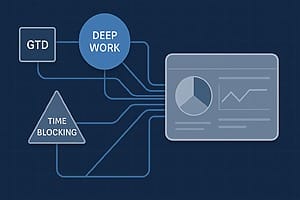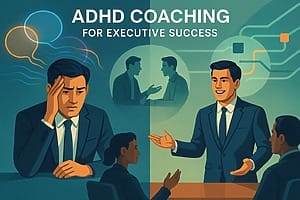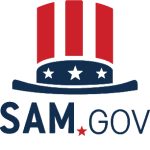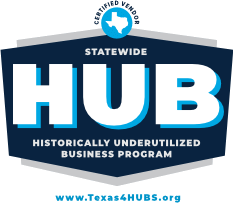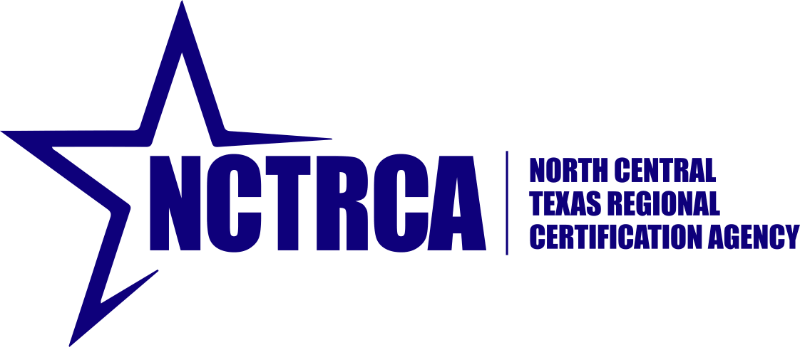TL;DR; ADHD can intensify work-life balance challenges, leading to burnout, relationship strain, and decreased performance. This article explores how specialized coaching helps professionals develop sustainable boundaries, energy management strategies, and integration techniques that work with ADHD traits rather than against them—creating harmony between professional success and personal wellbeing.
When Work Consumes Everything: The ADHD Work-Life Challenge
As someone who coaches professionals with ADHD, I’ve heard countless variations of the same struggle: “I’m either all-in at work and neglecting my personal life, or I’m trying to focus on family but constantly distracted by work thoughts. There’s never a balance.”
One executive I worked with described it perfectly: “I can hyperfocus on a project until 2 AM, completely losing track of time and missing dinner with my family. Then I feel guilty and try to compensate by being fully present on the weekend, but work anxiety creeps in. I’m never fully anywhere.”
This experience is remarkably common among professionals with ADHD. The same traits that can fuel career success—hyperfocus, creative problem-solving, and passionate engagement—can make work-life boundaries particularly challenging to maintain.
In our comprehensive guide to ADHD coaching for professionals, we explored how ADHD impacts workplace performance. Here, we’ll focus specifically on creating sustainable work-life integration—a challenge that affects not only professional effectiveness but also personal wellbeing and relationships.
Why ADHD Intensifies Work-Life Balance Challenges
Work-life balance is difficult for many professionals, but ADHD adds unique layers of complexity:
Time Blindness and Hyperfocus
Many adults with ADHD experience what experts call “time blindness”—difficulty perceiving the passage of time. This can lead to working well past intended stopping points, especially when engaged in hyperfocus.
A technology director I coached would regularly intend to work until 6 PM but find himself still deeply engaged at 9 PM, having missed family dinner. “I don’t even realize how much time has passed,” he explained. “I look up and suddenly hours have disappeared.”
Difficulty with Transitions
Shifting between different modes—from work focus to family engagement, for instance—can be particularly challenging with ADHD. The ADHD brain often needs more time and intentionality to make these transitions successfully.
One marketing executive described it as “carrying work residue” into her personal time. “Even when I physically leave the office, my mind is still solving work problems. I’m physically present with my family but mentally absent.”
All-or-Nothing Thinking
ADHD often brings a tendency toward black-and-white thinking, which can manifest as an all-or-nothing approach to work and personal life.
“I’m either completely immersed in work or feeling guilty that I’m not working,” shared a financial analyst client. “The idea of a middle ground seems impossible to maintain.”
Emotional Dysregulation
As we explored in our article on emotional intelligence for ADHD leaders, emotional regulation challenges can spill over between work and personal domains. Work stress may lead to irritability at home, while personal challenges can affect work focus and performance.
These ADHD-specific challenges don’t mean work-life harmony is impossible—far from it. With the right strategies and support, professionals with ADHD can create sustainable integration between their work and personal lives.
From Balance to Integration: A More Realistic Approach
For many professionals with ADHD, the concept of perfect “balance” can actually create more stress. Instead, I work with clients to develop what I call “intentional integration”—a more fluid approach that acknowledges the reality of modern professional life while creating meaningful boundaries.
The Integration Mindset
Integration starts with shifting from seeing work and personal life as competing forces to viewing them as complementary parts of a whole life. This mindset shift is particularly powerful for those with ADHD.
A senior executive I coached had an important realization: “I was trying to be two different people—’work me’ and ‘home me’—and the constant switching was exhausting. When I started seeing myself as one person with different contexts, everything got easier.”
This integration mindset doesn’t mean work should bleed into every aspect of life. Rather, it means creating intentional connections and boundaries that honor both domains.
Boundaries That Work With ADHD, Not Against It
Traditional boundary-setting advice often fails for professionals with ADHD because it doesn’t account for how the ADHD brain works. Through coaching, we develop boundaries that are:
- Clear and concrete rather than vague
- Visually reinforced with environmental cues
- Supported by routines that reduce decision fatigue
- Flexible enough to accommodate ADHD traits
A healthcare leader I worked with struggled with constant email checking during family time. Rather than setting an unrealistic “no work after 6 PM” rule, we created a more nuanced boundary: a 15-minute email check at 8 PM, with his phone in “do not disturb” mode at all other evening hours. This clear, specific boundary worked with his ADHD brain rather than against it.
Building Your Work-Life Integration Blueprint
Through years of coaching professionals with ADHD, I’ve identified several key strategies that help create sustainable work-life integration. These approaches are specifically designed to work with ADHD traits rather than fighting against them.
Time Blocking with Transition Buffers
Time blocking is a powerful technique for many professionals with ADHD, but it requires modification to support work-life integration. The key addition: transition buffers.
A technology executive transformed his work-life boundaries by adding 15-minute transition periods between work and home activities. “Those 15 minutes let me mentally close work loops before engaging with my family,” he explained. “I use them to jot down any lingering thoughts, take a few deep breaths, and reset my focus.”
This approach works because it acknowledges the ADHD brain’s need for more explicit transitions rather than expecting instant context-switching.
Energy Management vs. Time Management
For many professionals with ADHD, managing energy is even more important than managing time. This means recognizing when you’re at your best for different types of activities and structuring your day accordingly.
A marketing director I coached discovered that her strategic thinking was sharpest in the morning, while her capacity for emotional connection peaked in the evening. By scheduling client meetings in the morning and family time in the evening, she leveraged her natural energy patterns rather than fighting against them.
“I stopped feeling guilty about not being ‘on’ for my kids right after work,” she shared. “Instead, I take 30 minutes to decompress, and then I’m actually present and engaged with them.”
The Power of Rituals and Routines
While the ADHD brain often resists rigid schedules, it can thrive with meaningful rituals that signal transitions between different life domains.
One executive created what he called “bookend rituals” to separate work and home:
Morning Work Transition:
- 10-minute planning session with coffee
- Review of top three priorities
- Setting specific end-time intention
Evening Home Transition:
- 5-minute work shutdown routine
- Brief walk around the block
- Phone in “family mode” (notifications off)
These rituals created psychological boundaries that helped him be more present in each domain.
Preventing Burnout: A Critical ADHD Consideration
Professionals with ADHD may be particularly vulnerable to burnout due to their tendency toward intense work engagement and difficulty recognizing their own limits. As explored in our article on ADHD productivity strategies, sustainable performance requires intentional recovery.
The Burnout Warning Signs
Through coaching, we help clients recognize their personal burnout warning signs, which might include:
- Increased emotional reactivity
- Difficulty focusing even on interesting tasks
- Physical symptoms like headaches or sleep disturbances
- Loss of enthusiasm for previously engaging work
- Increased procrastination or avoidance
A financial services leader realized his first burnout warning sign was becoming unusually irritated by small client requests. “That’s my canary in the coal mine,” he noted. “When that happens, I know I need to step back and reset.”
Proactive Recovery Strategies
Rather than waiting until burnout hits, coaching helps develop proactive recovery practices that work with ADHD tendencies:
Micro-recoveries throughout the day – Brief moments of reset that appeal to the ADHD brain’s need for variety Movement breaks – Physical activity that helps regulate the ADHD nervous system Nature exposure – Time outdoors that can reduce ADHD symptoms and stress Structured disconnection – Planned periods away from work technology
A technology leader implemented what she called “recovery Wednesdays”—a midweek evening completely free from work where she engaged in a rock climbing class. “That midweek reset keeps me from reaching the breaking point,” she explained. “It’s non-negotiable time that actually makes me more productive overall.”
The Life Priorities Exercise: A Coaching Tool
One powerful coaching exercise I use with clients is the Life Priorities Alignment check. This helps identify disconnects between stated values and actual time allocation—a common issue for professionals with ADHD.
Take a moment to try a simplified version:
- List your top 5 life priorities (e.g., career, family, health, etc.)
- Next to each, note approximately what percentage of your time and energy currently goes to this area
- Then note what percentage you would ideally allocate to each
- Identify the largest gaps between current and ideal
This exercise often reveals surprising insights. One executive was shocked to realize he was giving less than 5% of his energy to health, despite ranking it as his second highest priority. This awareness led to meaningful changes in how he structured his week.
Setting Boundaries: Scripts for Success
Many professionals with ADHD struggle with setting and maintaining boundaries, particularly around work expectations. Through coaching, we develop personalized scripts for common boundary challenges.
The After-Hours Email Request
Situation: A colleague or client emails at 9 PM expecting an immediate response.
Boundary Script: “Thanks for your email. I’ve noted this for attention first thing tomorrow morning when I’m back online. If this is an emergency requiring immediate action, please call my cell.”
The Weekend Work Expectation
Situation: There’s an unspoken expectation to be available on weekends.
Boundary Script: “I’m focusing on family time this weekend to recharge for the week ahead. I’ll be checking messages Sunday evening to prepare for Monday. For urgent matters, please text me.”
The Vacation Interruption
Situation: Work issues intrude on scheduled vacation time.
Boundary Script: “I’m currently on vacation until the 15th to rest and recharge. For immediate assistance, please contact [colleague name]. For matters that can wait until my return, I’ll address them on the 16th.”
These scripts provide clear, professional language that helps maintain boundaries without apology or extensive explanation.
The Role of ADHD Coaching in Work-Life Integration
While the strategies above provide a starting point, lasting change in work-life integration typically requires the structure and support of coaching. As with other ADHD-related challenges, coaching provides several unique benefits:
Personalization Beyond Generic Advice
A coach helps you identify which integration strategies align with your specific ADHD traits, work demands, and personal values. This personalization is crucial—what works for one person with ADHD may be ineffective for another.
Accountability and Consistency
Coaching provides regular check-ins and accountability, helping you maintain boundaries even when work pressures intensify. This consistency is often the missing piece that allows new patterns to become established.
Addressing Underlying Beliefs
Many work-life integration challenges stem from underlying beliefs about success, worth, and identity. Coaching creates a safe space to examine and shift these beliefs, particularly those that may be amplified by ADHD experiences.
Practical Problem-Solving
When integration challenges arise—as they inevitably will—a coach helps you develop specific solutions rather than falling back into old patterns. This real-time problem-solving builds confidence and resilience.
A Transformation Story: From Burnout to Balance
To illustrate the impact of work-life integration coaching, consider this composite case study based on several client experiences:
The Challenge: Michael, a senior leader in a technology company, sought coaching because he was on the verge of burnout. Despite loving his work, he was working 70+ hours weekly, missing important family events, and experiencing health issues from stress. His ADHD made it particularly difficult to disengage from work, as he would hyperfocus on projects and lose track of time. His family was expressing frustration with his constant distraction and work preoccupation.
The Coaching Journey: Through our work together, Michael:
- Identified his core values and how his current patterns aligned (or didn’t) with those values
- Developed concrete boundaries with specific environmental cues
- Created transition rituals between work and home
- Implemented energy management strategies based on his ADHD patterns
- Practiced difficult conversations about boundaries with colleagues and family
The Transformation: Within four months, Michael had reduced his working hours to 50 per week without sacrificing productivity. He established a firm “no work on Sundays” policy and created a dedicated family dinner ritual four nights weekly. Most importantly, he reported feeling more present in both domains—more focused at work and more engaged at home.
“I used to think balance meant giving less to my work,” he shared. “Now I understand it means being more intentional about where my energy goes. I’m actually more effective at work because I’m not constantly depleted.”
Frequently Asked Questions
My job is extremely demanding; is work-life balance really achievable, or is it a fantasy?
It can certainly be hard in very demanding fields (like law, finance, start-ups), but even then, balance doesn’t mean equal time, it means the right allocation of time for you. Coaching can help identify small changes with big impact. For example, maybe you can’t reduce your 60-hour week right now, but you can make sure you disconnect on Sunday afternoons or integrate a 30-minute workout into your day to boost energy. Those changes can prevent burnout. Many executives find that once they implement a few boundaries and see productivity increase rather than decrease, they gain the confidence to preserve more personal time. It’s about strategic adjustments – and yes, it is achievable, often resulting in you performing even better at work.
How does ADHD affect work-life balance specifically?
ADHD can intensify work-life issues. You might hyperfocus on a work task and lose track of time, realizing late at night you’ve worked through dinner. Or you might procrastinate during the day due to ADHD distractions and then encroach on personal time to catch up. Also, ADHD can lead to saying “yes” too often (impulsively or out of eagerness to please), meaning you take on more than you can realistically handle. All these can upset any attempt at balance. The article discusses these, and importantly, how coaching helps create systems (like set routines and accountability) to counteract those ADHD tendencies, so you can have a thriving career and personal life.
What are some quick self-care practices for busy ADHD professionals? I feel I have no time.
Self-care doesn’t have to mean huge time commitments. A few quick ideas: 1) Micro-breaks: Take a 5-minute break every 90 minutes of work – stretch, get water, breathe. Even small pauses can reset your focus and reduce stress. 2) Tech off-time: Pick one or two periods in a day (e.g., during dinner, or after 9pm) where you put work devices away. This helps your brain disconnect and recharge. 3) Exercise snacks: If you can’t hit the gym, do 10-minute walks or a short set of exercises (push-ups, etc.) between meetings – it’s great for focus and mood. 4) Mindfulness minute: Try a one-minute meditation or deep breathing exercise a couple of times a day (perhaps after lunch and before bed). These are ADHD-friendly because they’re short and doable, yet they add up. Coaching often introduces clients to such tailored self-care routines that fit into even the busiest schedule.
I’m worried that if I work less, I’ll fall behind my peers. How do I balance ambition with self-care?
This is a common concern, especially among high achievers. But consider this: if you burn out, you won’t be performing at your peak anyway, and could even need extended time off. Sustainable productivity beats short-term overexertion. Many leaders actually discover that by strategically working a bit less (for instance, not working weekends), they force themselves to prioritize better and as a result become more efficient. It’s about working smarter, not just harder. Coaching can help you find that sweet spot – where you’re still achieving and advancing (maybe even more so) but not at the cost of your health or personal happiness. The article and coaching both reinforce that taking care of yourself is not the enemy of success, but rather a prerequisite for long-term success.
Build a Sustainable Success: Your Next Step
If you recognize your experience in what I’ve described, know that you’re not alone—and that change is possible. Many professionals with ADHD have transformed their approach to work-life integration through targeted coaching.
At Tandem Coaching, we specialize in helping busy professionals develop sustainable boundaries and integration strategies. Our approach combines evidence
it doesn’t seem to have finished generating. don’t regenerate the whole thing, just finish from Build a sustainable success: your next steps part
Build a Sustainable Success: Your Next Step
If you recognize your experience in what I’ve described, know that you’re not alone—and that change is possible. Many professionals with ADHD have transformed their approach to work-life integration through targeted coaching.
At Tandem Coaching, we specialize in helping busy professionals develop sustainable boundaries and integration strategies. Our approach combines evidence-based ADHD strategies with personalized support to create lasting change.
The path to work-life harmony isn’t about dramatic life overhauls or unrealistic boundaries. It’s about intentional adjustments that honor both your professional ambitions and personal wellbeing. As we’ve explored in our articles on leadership strategies and emotional intelligence, sustainable success requires a holistic approach.
Ready to build a more balanced and fulfilling life? Schedule a complimentary consultation to explore how ADHD coaching can help you develop work-life integration strategies that enhance both your career success and personal wellbeing. During this session, we’ll discuss your specific challenges and goals, and determine if our approach aligns with your needs.
Don’t let burnout or imbalance derail your career or personal life. Your future self (and your loved ones) will thank you for taking this step toward sustainable success.
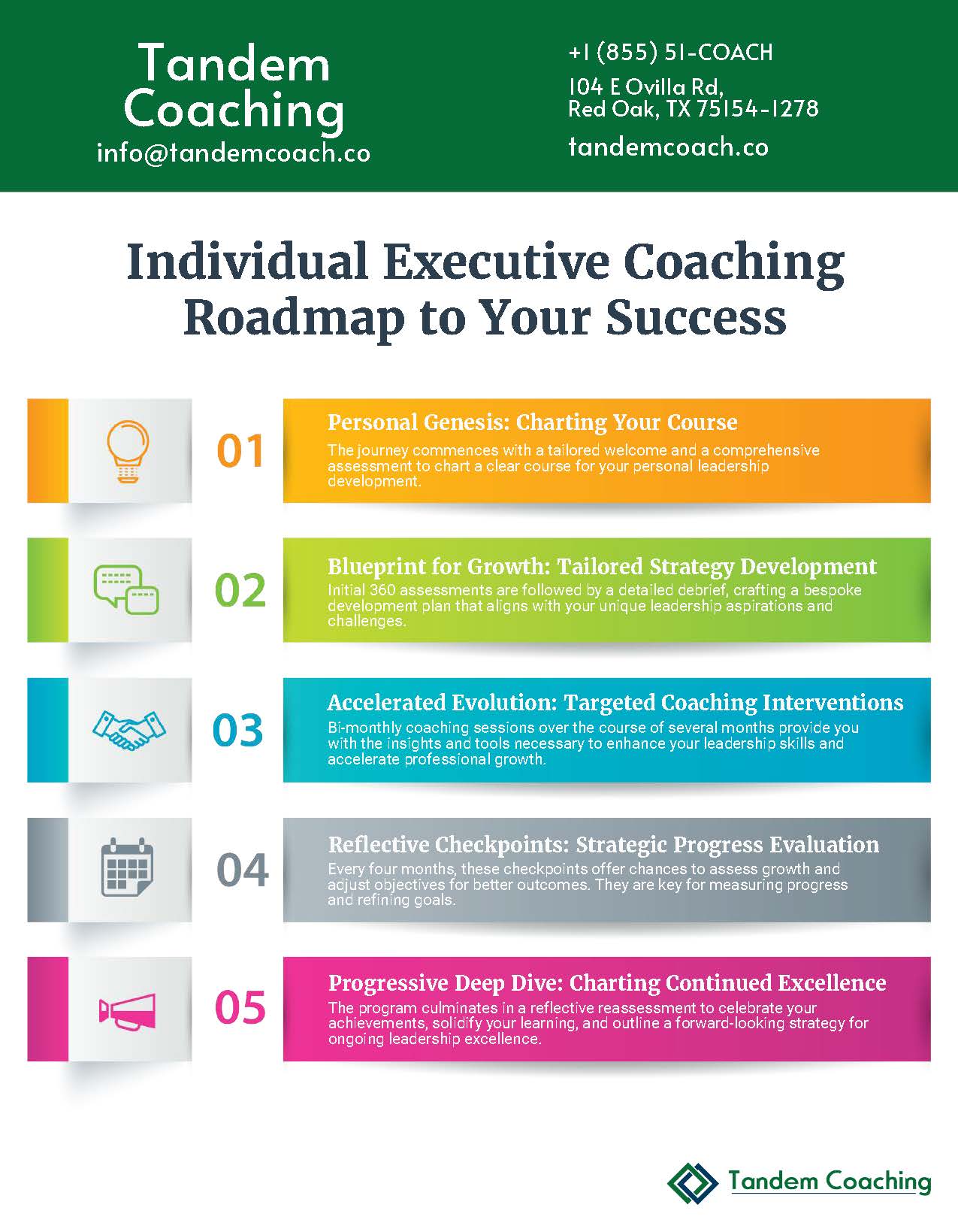
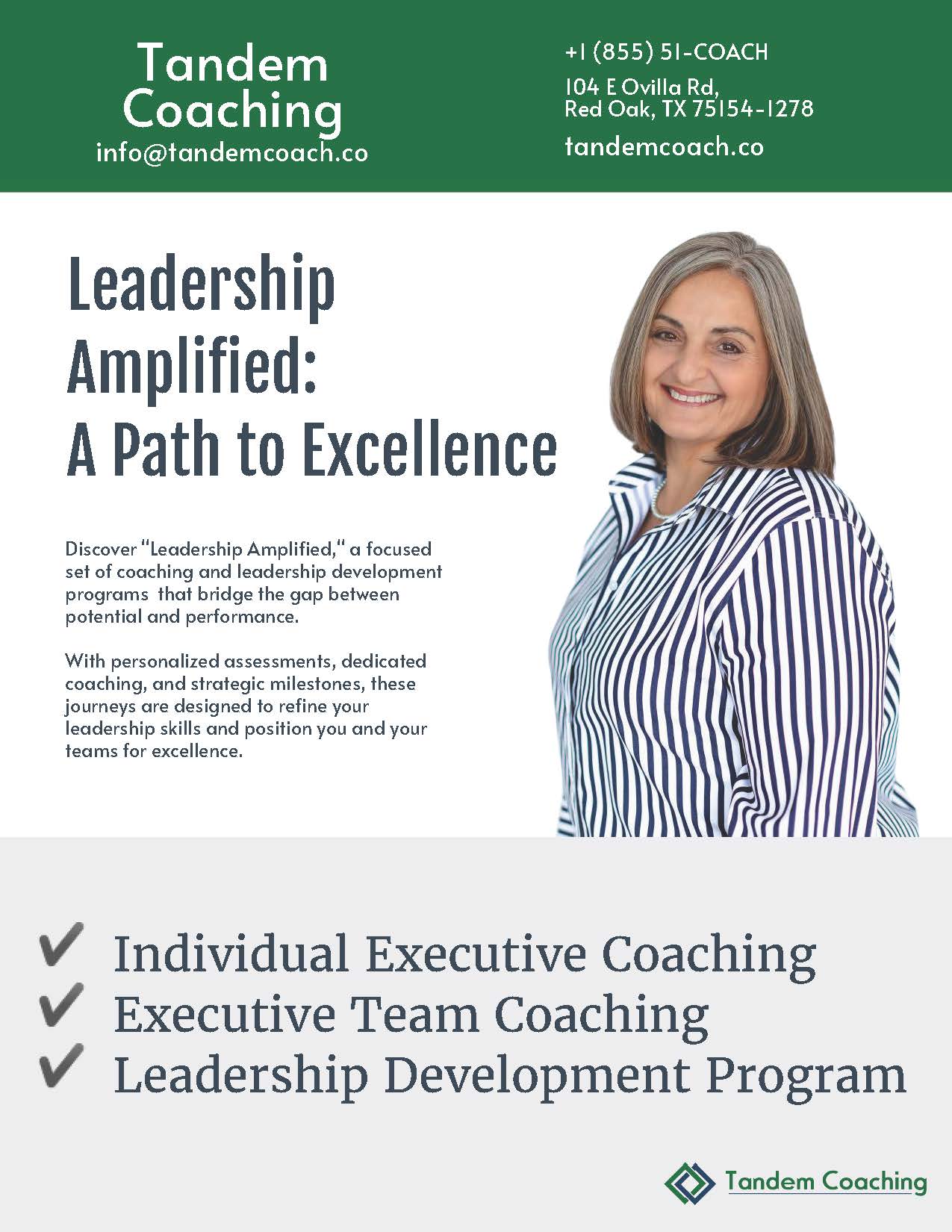
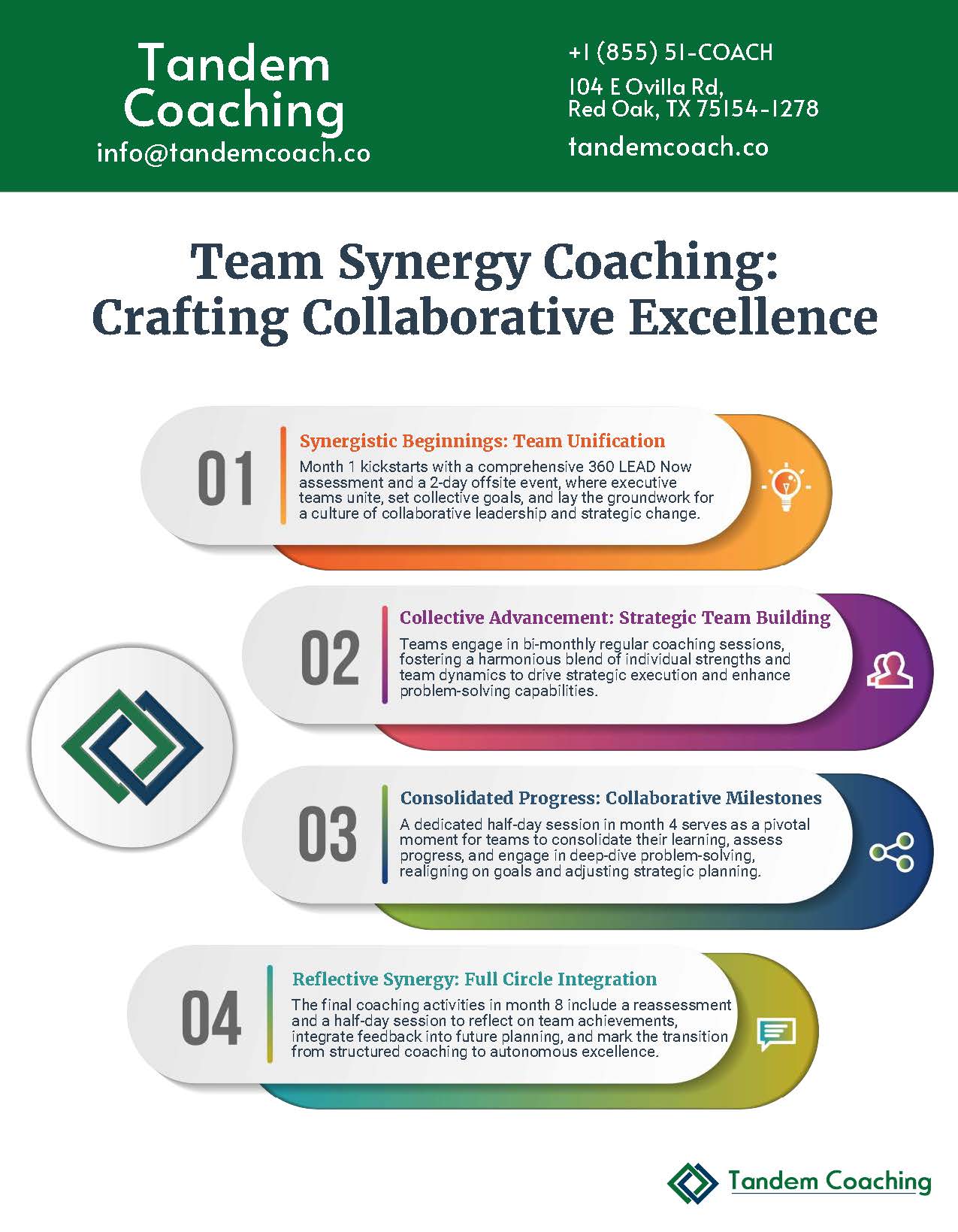
Boost Your Leadership Team Success!
Take your leadership team to the next level and achieve great results with our executive coaching.
Learn how our coaching and ASPIRE method can change things for you—get a free brochure to begin your journey.
About the Author
Cherie Silas, MCC
She has over 20 years of experience as a corporate leader and uses that background to partner with business executives and their leadership teams to identify and solve their most challenging people, process, and business problems in measurable ways.

